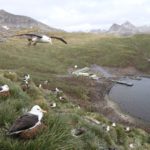White-chinned Petrel Tracking
White-chinned Petrel Tracking
- Start date
- 1 April, 2015
- End date
- 31 July, 2015
The white-chinned petrel is the most common bird species recorded as fisheries bycatch in the Southern Ocean [1]. Although currently listed as Vulnerable by the IUCN, limited population trend data provide some grounds for uplisting to Endangered, with the decision dependent largely on better information from South Georgia, which holds more than half of the world population [2].
At Bird Island, there was a decrease of 28% (equivalent to 2% per year) in nesting burrow occupancy from the late 1970s to late 1990s. Based on existing tracking data, the greatest overlap between adult birds and fisheries, and therefore the greatest risk of bycatch, occurs on the Patagonian Shelf during the pre-laying period, and on the Patagonian Shelf and off southern Chile during the non-breeding period [1][3]. However, non-breeders (10 birds) have been tracked in only one year, and stable isotope analysis of feathers [5] from a larger sample suggests that a small proportion also spend the winter in the Benguela Upwelling region [4]. Nothing is known about the movements of juveniles.
In mid April 2015, 13 satellite tags (PTTs) made by Telonics (TAV-2630) were attached to white-chinned petrel chicks prior to their departure from Bird Island. The birds were tracked in near real-time using the Argos system, and their locations shown on the following map.
Click on a track to find out how far the bird has gone from Bird Island.
Funding for the devices was obtained from the South Georgia Government fisheries licence fees, and this tracking is part of a wider study that involves deployment of geolocators to track nonbreeding movements and at-sea activity patterns of adults at South Georgia, and in the Falkland Islands (the latter with Falklands Conservation and ISPA at New Island).
Further reading
[1] Phillips, R.A., Silk, J.R.D., Croxall, J.P. and Afanasyev, V. (2006) Year-round distribution of white-chinned petrels from South Georgia: relationships with oceanography and fisheries. Biological Conservation 129, 336-347.
Available at http://www.seaturtle.org/PDF/PhillipsRA_2006_BiolConserv.pdf
[2] Martin, A. R., Poncet, S., Barbraud, C., Foster, E., Fretwell, P., & Rothery, P. (2009).The white-chinned petrel (Procellaria aequinoctialis) on South Georgia: population size, distribution and global significance. Polar biology, 32, 655-661.
[3] Mackley, E.K., Phillips, R.A., Silk, J.R.D., Wakefield, E.D., Afanasyev, V., and Furness, R.W. (2011). At-sea activity patterns of breeding and nonbreeding white-chinned petrels Procellaria aequinoctialis from South Georgia. Marine Biology 158, 429-438.
Available at http://link.springer.com/article/10.1007/s00227-010-1570-x#page-1
[4] Phillips, R.A., Bearhop, S., McGill, R.A.R. and Dawson, D.A. (2009) Stable isotopes reveal individual variation in migration strategies and habitat preferences in a suite of seabirds during the nonbreeding period. Oecologia 160, 795-806.
Available at http://link.springer.com/article/10.1007/s00442-009-1342-9#page-1
Footnote
[5] Carbon and nitrogen stable isotope ratios in animal tissues are natural biomarkers, providing information on distribution (latitude, water mass or the relative importance of benthic/inshore prey) and trophic level, respectively.
This project aims to track the dispersal of juvenile white-chinned petrels as they leave their nest burrows on Bird Island, South Georgia.
